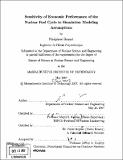| dc.contributor.advisor | Mujid S. Kazimi. | en_US |
| dc.contributor.author | Bonnet, Nicéphore | en_US |
| dc.contributor.other | Massachusetts Institute of Technology. Dept. of Nuclear Science and Engineering. | en_US |
| dc.date.accessioned | 2008-04-23T14:44:31Z | |
| dc.date.available | 2008-04-23T14:44:31Z | |
| dc.date.copyright | 2007 | en_US |
| dc.date.issued | 2007 | en_US |
| dc.identifier.uri | http://hdl.handle.net/1721.1/41312 | |
| dc.description | Thesis (S.M.)--Massachusetts Institute of Technology, Dept. of Nuclear Science and Engineering, 2007. | en_US |
| dc.description | Includes bibliographical references (p. 129-130). | en_US |
| dc.description.abstract | Comparing different nuclear fuel cycles and assessing their implications require a fuel cycle simulation model as complete and realistic as possible. In this thesis, methodological implications of modeling choices are discussed in connection with development of the MIT fuel cycle simulation code CAFCA. The CAFCA code is meant to find the recycling facilities deployment rate that minimizes the time by which spent fuel in storage today is used up in order to lead to a nuclear fuel cycle with minimum inventory of transuranic elements. The deployment is constrained by the recycling plants construction capacity and also by the economic requirement that the recycling plants loading factor never drops below a certain level. First, through a simplified fuel cycle model, it is analytically proven that an optimum solution is to build recycling plants at full speed up to a certain point in time b, then to suspend construction until interim storage gets completely depleted. The shape of the optimum solution, parameterized by b, is injected into an algorithm based on a complete model of the fuel cycle. An iterative process yields the value of b assuring depletion and satisfactory loading factors. Besides providing rigorous optimization,this analytical solution underpinning the CAFCA algorithm is expected to reduce considerably the vulnerability of the results to numerical discontinuities. Degradation of fuel quality with time in interim storage occurs due to the decay of Pu241 into Am241. While an obvious approach to track such effects is to couple the fuel cycle code with a neutronics/decay code (ORIGEN for example), it is more efficient to derive explicit equations from a simplified irradiation and decay model, allowing for analytical tracking of the fuel composition. | en_US |
| dc.description.abstract | (cont.) All fuel cycle simulation refinements do not present the same level of importance. One should focus on the dominant parameters as those contributing the most to overall results sensitivity. A novel U.S. thermal recycling scenario called CONFU is taken as a reference case. The CONFU technology is introduced 15 years from now, with an industrial capacity allowing the construction of one 1000 MT/year spent fuel separation plant every two years. Discharged CONFU batches remain in cooling storage for 6 years. Reactors have a 60 years lifetime and economic ecovery period of 20 years, and are half financed by equity with a rate of return of 15%. It is found that the cost of electricity is most sensitive to the reactors lifetime, since taking it back to its initial nominal value of 40 years would result in a 44% increase in the cost of electricity. Next in importance is the financing structure of the fleet. The addition of three points to the rate of return on equity would increase the cost of electricity by 14%. While scale effects are locally very beneficial in that they substantially reduce recycling plants operation costs, they prove to be of limited interest from an overall fuel cycle point of view. Using the scale effect model in CAFCA-II, doubling the separation plants capacity yields a 3% reduction of the cost of electricity. The fuel cycle presents good robustness with respect to fuel decay time degradation. Increasing CONFU batches cooling time to 18 years causes a 2% increase in the cost of electricity. | en_US |
| dc.description.statementofresponsibility | by Nicéphore Bonnet. | en_US |
| dc.format.extent | 130 p. | en_US |
| dc.language.iso | eng | en_US |
| dc.publisher | Massachusetts Institute of Technology | en_US |
| dc.rights | M.I.T. theses are protected by
copyright. They may be viewed from this source for any purpose, but
reproduction or distribution in any format is prohibited without written
permission. See provided URL for inquiries about permission. | en_US |
| dc.rights.uri | http://dspace.mit.edu/handle/1721.1/7582 | en_US |
| dc.subject | Nuclear Science and Engineering. | en_US |
| dc.title | Sensitivity of economic performance of the nuclear fuel cycle to simulation modeling assumptions | en_US |
| dc.type | Thesis | en_US |
| dc.description.degree | S.M. | en_US |
| dc.contributor.department | Massachusetts Institute of Technology. Department of Nuclear Science and Engineering | |
| dc.identifier.oclc | 214328281 | en_US |
